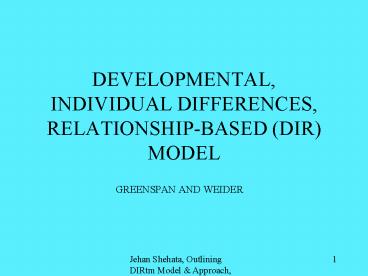DEVELOPMENTAL, INDIVIDUAL DIFFERENCES, RELATIONSHIP-BASED (DIR) MODEL PowerPoint PPT Presentation
1 / 21
Title: DEVELOPMENTAL, INDIVIDUAL DIFFERENCES, RELATIONSHIP-BASED (DIR) MODEL
1
DEVELOPMENTAL, INDIVIDUAL DIFFERENCES,
RELATIONSHIP-BASED (DIR) MODEL
- GREENSPAN AND WEIDER
2
FLOORTIME APPROACH A Comprehensive,
Individualized Developmentally Based Interactive
ApproachDeveloped by Stanley Greenspan and
Serena Weider
3
RESEARCH CONSENSUS Core Deficits
- Difficulties Integrating and Processing Complex
Information - Higher Level Thinking Abstract, reflective
thinking, making inferences generating ideas .
(Minshew Goldstein, 2000. Bishop Norbury,
2005) - Problems of Relating and Communicating
- Relating Experiencing high levels of relatedness
and empathy. (Hillier Allinson, 2002) - Communicating Engaging in reciprocal affective
interactions as part of a continuous flow of
interactive problem-solving.(Minshew Goldstein,
2000)
4
Research Consensus
- The Role of Emotion in Learning and Human
- Development is supported by
- Recent neurological research
- Knowledge of the pathways that process emotion
- The impact of emotional stress on the brain
- The impact of brain lesions on emotional
regulation - The recognition of the social origins of
cognition (Dennis, Lockyer Lazenby,
2000.Greenspan Shanker, 2004, p. 22)
5
Emotional Signaling and Concept Formation
- Emotional signaling in repeated pleasurable,
synchroniesed interactions with significant
others in the first years of life leading to the
development of images, is the link between
sensory perceptions symbol/concept formation,
such as that of the Mother. (Greenspan and
Shanker, 2004, p. 29)
6
Emotional Signaling
- A reciprocated flow, between infant mother of
- Facial expressions anger, fear, sadness,
happiness or excitement disappointment etc - Gestures waving arms or reaching at arm length,
pointing etc - Vocalizations cooing, bubbling
7
The Harris Research Program On Human Development
- Stuart Shanker and Stanley Greenspan
- caregivers interactive style
- childs genetic and biological constitution
- maturation
- impact on the childs level of emotional
signaling - functional/emotional development affective
transformation, language formation,
social-emotional intellectual thinking - detecting early derailments
- implementing early intervention
8
The DIR Model
Environmental (Parents/Caregivers) Interaction
Patterns and Dynamics
NURTURE
The Individual Constitutional and
Maturational Characteristics NATURE
The Individual Developmental Core
Capacities and Functioning
9
(No Transcript)
10
Developmental Profile
Biomedical Excess or Difficiency
- Child Developmental
- Core Capacities
- Selfregulation
- Attention
- Engagement
- Purposeful gesturing
- Behavioralorganization
- Problem Solving
- Emotional thinking
- Sharing of ideas
- Bridging ideas/feeling
- Child-Parent
- Interaction Patterns
- Current patterns
- Optimal patterns
- re. Child s
- Core Capacities
- Individual Differences
- Child s Processing
- Individual Differences
- Auditory-Visual Processing
- Sensory-Motor/Perceptual
- Sensory Integration Skills
- Modulation
- Language
11
Biomedical Intervention
- Specific Therapy
- Speech/Language
- Occupational or
- Physio-Therapy
- Auditory/Visual
- Perceptual Training
Family Support
Comprehensive Functional Developmental Interventio
n Program
- Home Programing
- Spontanious
- developmentally based
- interactions
- Semi-Structured
- sensory-motor
- Structured
- perceptual activities
- School Programing
- Spontaneous,
- developmentally based
- interactions
- Semi-Structured
- sensory-motor
- Structured
- Perceptual activities
12
Class Structure
- School
- Program
- Includes three elements
- Spontaneous, developmentally
- appropriate interactions
- Semi-structured sensory-motor visual spatial
- Structured pre-academic or academic
- educational activities
Additional Educational Strategies
13
Class Structure
Inclusion or Regular Class placement with an
aide If the preschooler is able to use complex
gestures or words, priority should be given to an
inclusive or a regular class with an aide
Special Need Classes If the child is not using
complex gestures to problem solve is not
imitating or using words, prioprity should be
given to a special need class with a 11 ratio
14
Additional Educational Strategies
Miller Method
PECS
TEACCH
ABA
- Visual-Spatial
- Thinking
- Perceptual-Motor
- excercises
- Visualization-based
- concept building
Augmentative Communication Systems
15
Additional EducationalStrategies
- PECS
- When language lags behind visual-spatial thinking
- TEACCH
- When motor planning difficulties impede gestural
communication - ABA
- When structured excercises could be used to
facilitate the development of imitation skills,
basic motor planning and sequencing skills in
children. - Miller Method
- To help the child master early, basic cognitive
capacities
16
(No Transcript)
17
(No Transcript)
18
(No Transcript)
19
(No Transcript)
20
(No Transcript)
21
(No Transcript)

